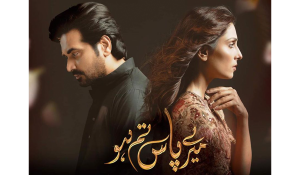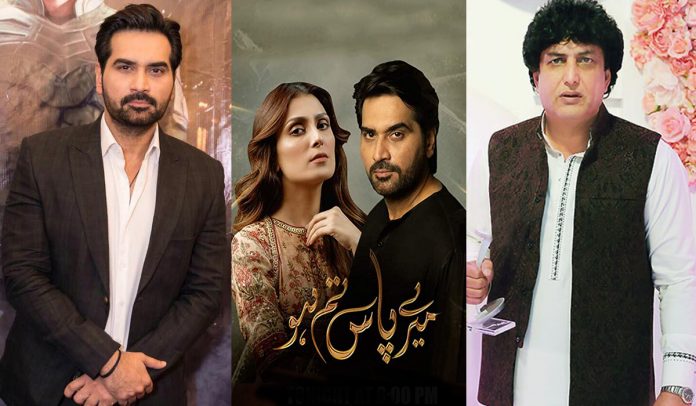Meray Paas Tum Ho came, it saw, and it conquered – there is no better way to succinctly describe the phenomenon this drama was. Or we could say it would remain for the foreseeable future because it is going to be so hard, if not impossible, for any other drama to have the entire nation under its grip the way this Humayun Saeed production did. It was a show that was marketed very cleverly and strategically by its entire team. Which other drama can boast of the tactics that MPTH applied? Heck, it can give even our movies a run for their money when it comes to marketing lessons.
It started before the pink nighty
A couple of episodes before the now-infamous “Pink Nighty” scene, ARY Digital and the show’s production team, had already started to hint towards the major twist that would shock the viewers. From releasing special promos to the cast using their social media following to build suspense about an otherwise average story, those were the first signs of the show using any and all means necessary to make sure that it became THE most talked about show of the town. Even as its competition show Alif struggled to get the major chunk of the audience hooked to its more nuanced and complex story, MPTH continued to rope in more and more viewers to the point that when the show dangled the sweet treat of enjoying its ending on the big screen, there were queues ready to fill up the halls.
Ah, the ending. Unlike what some news portals, including Galaxy Lollywood, were led to believe that MPTH supposedly had three endings, the show just had one. And now that the show has milked itself to the maximum of its capabilities, its production team is coming clean about its tall claims.
Three endings? Ha!
Humayun Saeed talked about the ending of Meray Paas Tum Ho in an insta-live session and clarified that he had deliberately lied about the show having three possible endings. Glowing in the happiness of giving the box office yet another blockbuster, Humayun was in quite a jolly mood as he talked about how the audience had been predicting that his character, Danish, would end up dying since the show’s first episode aired.
“It’s like [the audience] saw something on my face and started predicting that Danish would die. Even recently when a few people asked me what the ending of the drama would be like, I told them that Danish would die. But nobody would believe that. They thought I was lying when I was telling the truth,” he said, before dropping the bombshell: “The show never had three endings, it always had one. That was a lie.”
And then there were some more
This speaks volumes about the interest that the nation had in everything MPTH. With the way everyone was desperate to find out any kind of crumbs about the show’s story or its twists, it’s not surprising that the show’s cast had used all that interest to keep the show in the spotlight even if it meant taking us on a ride. For instance, when Humayun made a social media post about one of the most important episodes of the drama not being available online just hours before the episode was to be aired on television had the audience glued to their television screens. The “do takay ki aurat” line was witnessed by a large number of audience on television. The episode ended up becoming available online after 9 PM on ARY’s Youtube channel the way it normally did every week. Humayun even wasn’t the first one to misinform (intentionally or not) about something that never happened in the show.
Hira Mani had in an interview talked about how Mere Paas Tum Ho might have a character that would be murdered. Something that we now know did not happen at all. But back when Hira had revealed this “spoiler”, it had become the topic of discussion for the audience as they theorized about which character would die and in what matter. An utter waste of time in hindsight but back then, it seemed like the most logical thing to do.
 The writer who created more drama off-screen
The writer who created more drama off-screen
And if we start to talk about how the drama’s writer contributed to making sure that it tended, then we’d be here for a long time. No, we aren’t talking about Khalil ur Rahman Qamar’s writing skills but rather all the rather, ahem, unique insights that he shared on the topics of feminism, infidelity, and the nature of men and women during his various interviews around the time when Mere Paas Tum Ho was on-air. The question of separating the art from the artist sprung up again. Would it be wrong to say that this whole debate even made many intellectuals question their morals? How does one actually openly defy or criticize a piece of media that is such a rage all around the country, if one even dares?
One of the leads of the show, Adnan Siddiqui, has accepted the show’s problematic writing and expressed his wish for the drama being more nuanced in its portrayal of women, but one does wonder where was this energy while the show was on-air? When it was the right time to talk about it because the debates and discussions were not only heated but relevant. Back then Adnan, alongside the show’s other cast, was busy in basking in the glory that the show was giving them and enjoying their characters’ dialogues going viral all around.
Now that the drama has finished its run and all manners of discussions around it as well as all variations of the memes that it gave birth to have been done and dusted, it does make us wonder what the post-MPTH future of Pakistani drama would be like. Sonya Hussain, who was one of the choices to play the role of Mehwish before Ayeza Khan ultimately made the character her own, has talked about her turning down the role saying she couldn’t “see women being characterized in such negative light” and that she did not want to be a part of the show that would perpetuate more issues for women in a society that is already so hard on the gender. It is an admiring stance to take but we do wonder, would the other mainstream actors be able to take such a stand?
Final word
Meray Paas Tum Ho was certainly a lot. From all possible ways to explain it, this is the one way that can capture the emotions and sentiments behind the all-consuming nature of this drama. It did wonders for every person involved in the drama be it behind the camera or in front of it. And it wasn’t just because the drama just had excellent acting and mind-blowing level of writing. A large reason why Mere Paas Tum Ho became big was the very conscious efforts put behind it to make it big.
As we all know in Pakistani drama industry all it takes is one successful project to usher in a big string of projects following the same formula to replicate that one project’s success. MPTH has given the industry new lessons on how to not just make a drama but how to package it and advertise it. Its success lies behind the collective effort of the channel, the production house, and the actors all coming together to grip the audience. Who is to say future projects across different channels won’t follow the same methods? Now that MPTH has made an example that successful dramas can have poor men in the role of a victim and the lead heroine of the project being the vamp in disguise, maybe the trend of a roti-dhoti aurat would be replaced with images of rota-dhota mard.
Who knows? 2020 has just begun.




